The Ultimate Guide To Buying The Ideal Juicer
Choosing the best juicer becomes easier if you know the basic details about the different types of juicers, their pros and cons, and what they’re best suited for. Let’s get to it:
3 Main Types of Juicing Machines
Depending on your budget and your juicing needs, you can choose any of the following three types of juicing machines:
- Centrifugal Juicers
- Masticating Juicers, aka Single Auger Juicers Or Single Gear Juicers
- Twin Gear Juicers aka Triturating Juicers
There are also some other less common, typical variations such as wheat grass juicers, citrus juicers and sugarcane juicers. Let’s briefly explore all these to determine which is the ideal juice machine for your kitchen.
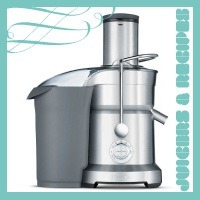 1. Centrifugal juicers
1. Centrifugal juicers
This is the most common type of juicers which processes fruits, veggies and other produce with a shredder disc rotating at a high RPM. Usually, the item to be juiced is pushed in through a feed chute and pressed down with a tamper. The price of these juicers varies, depending mainly on their build i.e. juicers made of stainless steel can cost you anything upwards of $300 while others having plastic body can be as cheap as $60.
Pros: Economical, high yield, quick, compact, easy to clean, readily available in the market
Cons: Noisy, the juice gets oxidized and can’t be stored for too long, won’t juice wheatgrass
Ideal for: Harder veggies and fruits, some models can juice leafy greens
Recommended Models:
Roland Magimix Le Duo Plus Juicer
Champion 2000 Household Model Juicer G5-NG-853S
Jack Lalanne PJP Power Juicer Pro Stainless-Steel Electric Juicer
Variations of Centrifugal juicers
[three_columns_1]Non ejection centrifugal juicers
This is the most basic type of centrifugal juicers. The juice comes out from the spout (usually at the front), however the pulp remains inside the shredder disc – so you must stop the juicer after about one quart of juice.[/three_columns_1] [three_columns_2]Automatic ejection centrifugal juicers
The pulp is automatically collected in a container or into your garbage bin through a spout for continuous juicing. It’s a common choice for larger families, spas and juice bars.[/three_columns_2] [three_columns_3]Centrifugal juicers with a wide feed chute
Some of the newer models come with a feed tube as wide as 3 inches. They considerably reduce prep work by accepting uncut (or larger chunks) of fruits and veggies.[/three_columns_3]
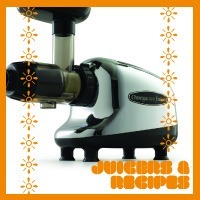 2. Masticating Juicers
2. Masticating Juicers
(Single Gear Juicers
Single Auger Juicers)
These juicers utilize an auger with blades (can be correlated to human teeth) to ‘chew’ (masticate) the produce in order to extract the juice. The auger rotates at a slow speed to avoid heat buildup, though most single auger juicers come with a very powerful motor. Produce is pushed into the feed chute, pushed down with a tamper while the juice comes out from a spout at the front and pulp can be collected in a bin.
These are usually more versatile as compared to centrifugal juicers, since they can juice a wide variety of produce including fruits, veggies, leafy greens, and even wheatgrass. On top of this, they can be used to homogenize foods, process baby foods, make nut butters & fruit desserts and many other dishes.
Pros: High yield, easy to clean, durable, offer higher nutritional value, can process most types of items, quite affordable, less foam and pulp in juice, very quiet, can act as a multipurpose appliance (i.e. fruit and veggie juicer, food processor, homogenizer, nut butter maker, wheatgrass juicer etc.)
Cons: Slow, big in size, heavy, more expensive as compared to centrifugal juicers
Ideal for: Most types of fruits as well as wheat grass and leafy greens
Recommended Models:
Omega J8005 Nutrition Center Single-Gear Commercial Masticating Juicer
Sunkist SK830 Masticating Juicing Machine
Sidenote, are you juicing for weightloss?
We recommend you watch this film for inspiration!
Variations of Masticating Juicers
Upright Masticating Juicers
Single gear juicers need more space, hence they are ideal for business use or homes that have a spacious kitchen. Some manufacturers, however, offer a revolutionary new patented design, these are referred to as upright masticating juicers. They work just the same as the conventional masticating juicers, but are upright to save space.
Recommended Model:
Hurom HU-100 Masticating Slow Juicer
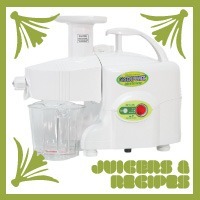 3. Twin Gear Juicers
3. Twin Gear Juicers
(Triturating Juicers)
As the name suggests, juicers of this design have two inter-meshing gears – made of stainless steel – that press the produce between them. They are pretty similar in shape to masticating juicers, but offer higher yield and even higher nutritional value. Since the twin gears rotate at speeds lower than 200 rpm (usually around 80 rpm), there is hardly any heat accumulation or oxidization of the juice.
Being the most efficient type of juicers, they are an ideal choice for raw food enthusiasts, juice bars, and spas since they can process the widest range of produces and offer maximum nutritional value. Moreover, they can produce a wider variety of recipes and beverages.
Pros: Highest yield, durable, highest nutritional value, can juice almost all types of produces, hardly any foam and pulp in the juice, very quiet, can act as the ultimate multipurpose kitchen appliance
Cons: Not very affordable, slow, big in size, heavy, not particularly easy to clean
Ideal for: Almost every kind of produce
Recommended Models:
Super Angel 5500 Stainless Steel Living Juice Extractor
Green Power KPE1304 Twin Gear Juicer
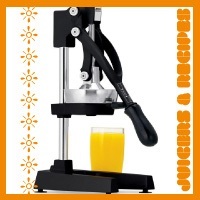 Citrus Juicers
Citrus Juicers
Normal juicers are often not that efficient for juicing citrus fruits. So if you fancy sap extracted from oranges, grapefruits, pomegranates, limes or lemons, you might want to consider getting a dedicated citrus juicer or press. You can find electric, manual and even handled citrus juicers depending on your needs.
Pros: Easy to use and wash, very quick and efficient, very affordable
Cons: Only juice citrus fruits, manual citrus juicers are usually large
Ideal for: Oranges, grapefruits, pomegranates, limes or lemons
Recommended Models:
Breville 800CPXL Die Cast Stainless Steel Motorized Citrus Press
Olympus Extra Large Commercial Juice Press
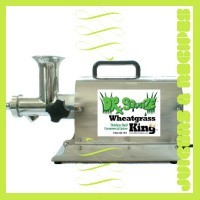 5. Wheat grass juicers
5. Wheat grass juicers
Though most masticating juicers (except some models by Champion) and all the twin gear juicers are capable of extracting juice from wheatgrass, you might still want to consider a dedicated wheat grass juicer for added yield and easier use. Their appearance and workings is like that of the masticating juicers, but the only juice wheatgrass.
Pros: Easy to use, very quick and efficient, durable, very quiet
Cons: Generally cost a bit, heavy, larger footprint, suited for wheatgrass only
Ideal for: Wheatgrass
Recommended Models:
Miracle Pro Green Machine Wheat Grass Juicer
Our honest advice when contemplating which type of juicer to buy:
Buying a cheaper juicer might save you a few bucks at that time, but usually they accumulate more expenses in the long run, this is due to various factors such as cost of repairs, poorer efficiency, less productivity, juice quality and ease of use. But we also wouldn’t recommend that you buy the most expensive model as your first juicer – just keep in mind your very juicing needs and expectations and go for a high-quality, reasonably priced model, especially if you are new to juicing. Once you have established that fresh juice is something you want to consume regularly and are familiar with the different juicer types, then you can perhaps justify a larger investment and in turn might end up with a machine that will meet your juicing needs for life.
To your health 🙂
Juicers & Recipes


